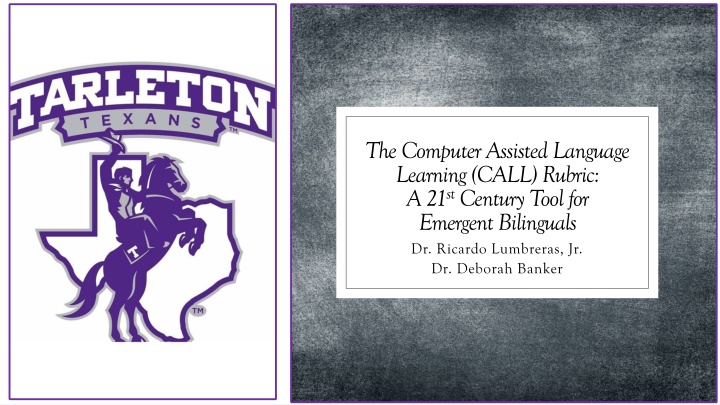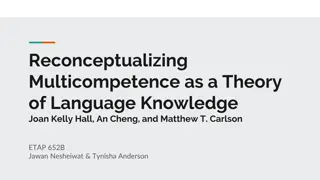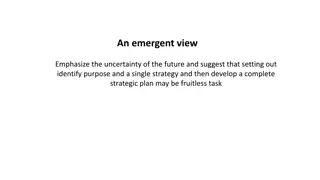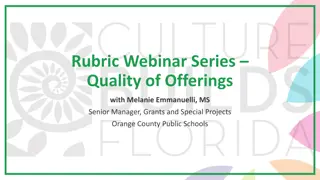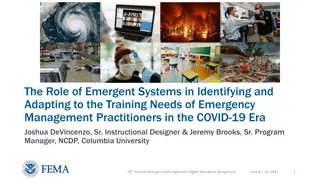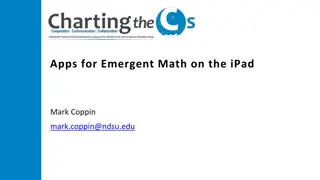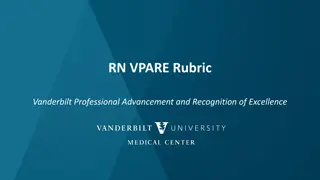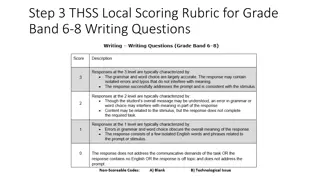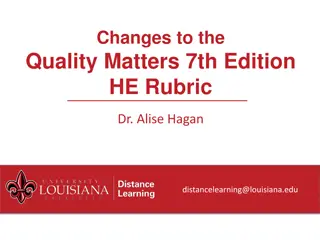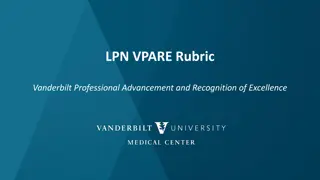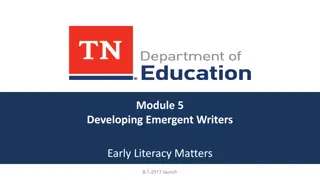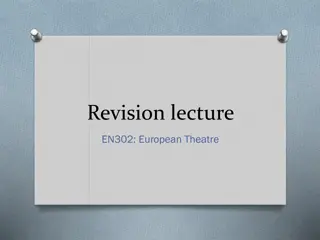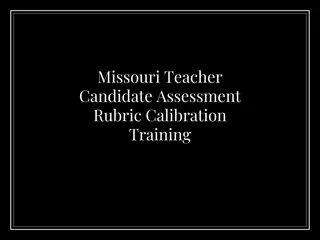CALL Rubric for Emergent Bilinguals
Explore a comprehensive rubric for evaluating Computer-Assisted Language Learning tools tailored to emergent bilingual students. Delve into frameworks, proficiency standards, and exemplary criteria essential for effective language acquisition in the 21st century.
Uploaded on Mar 02, 2025 | 0 Views
Download Presentation

Please find below an Image/Link to download the presentation.
The content on the website is provided AS IS for your information and personal use only. It may not be sold, licensed, or shared on other websites without obtaining consent from the author.If you encounter any issues during the download, it is possible that the publisher has removed the file from their server.
You are allowed to download the files provided on this website for personal or commercial use, subject to the condition that they are used lawfully. All files are the property of their respective owners.
The content on the website is provided AS IS for your information and personal use only. It may not be sold, licensed, or shared on other websites without obtaining consent from the author.
E N D
Presentation Transcript
The Computer Assisted Language Learning (CALL) Rubric: A 21stCentury Tool for Emergent Bilinguals Dr. Ricardo Lumbreras, Jr. Dr. Deborah Banker
What the research says about the need to evaluate online learning tools Duarte & Barros (2018) suggest that although it is relatively simple to implement a surface approach to learning, it is not easy to encourage a deep approach (p. 4). Nix & Wyllie (2011) as cited in Bahari (2021) further suggest interactive assessment makes it possible to offer learners a choice on entering the assessment environment, greater engagement and control of the learning experience and instant feedback (p. 65). We have moved beyond the four language acquisition domains of listening, speaking, reading, and writing to include viewing and representing visually (Sehlaoui, 2018). Rogerson-Revell (2021) suggests the increasing attractiveness and availability of CALL tools is more technology driven as opposed to being pedagogy-led. Therefore, it lacks the pedagogic tools to ensure effective language acquisition. So, what is the framework for this rubric?
The ELPS & WIDA Language Proficiency Standards Initially, the framework was designed & aligned with the English Language Proficiency Standards (ELPS) from the State of Texas. The ELP standard categories are as follows: Beginner, Intermediate, Advanced, Advanced- High. The researchers expanded the framework proficiency standards to include the nationally recognized World-Class Instructional Design and Assessment Consortium (WIDA) language proficiency standards. The intent was to broaden the scope of the framework to include language proficiency levels that better represented Emergent Bilingual students language acquisition abilities.
EXEMPLARY The tool is prepared and maintained by an accredited, verifiable, and contactable source. It is usable, accessible, and findable. Source
EXEMPLARY Content The tool allows students to practice targeted grade-level math, reading, science, and social studies objectives.
EXEMPLARY Accuracy The tool allows users to practice sentence structure, vocabulary, and grammar within the chosen content area.
EXEMPLARY Comprehensibility & Pronunciation The tool allows users to understand all contextual cues, respond to those content-specific cues, and practice responding appropriately.
EXEMPLARY Feedback The user is provided specific, content area, and language domain feedback.
EXEMPLARY Customizable Learning The tool allows flexibility in altering content and settings to meet individual linguistic needs, including diagnostic capabilities, measurement of language level, and proficiency level movement.
EXEMPLARY Engaging The user is self-directed and highly motivated to use the tool.
EXEMPLARY Allows students to engage the six language domains: (L,S,R,W,V,R) Users can practice listening, speaking, reading, writing, viewing, and representing in specific and targeted content areas.
Allows students to engage the six language domains (L, S, R, W, V, R) LISTENING SPEAKING READING WRITING VIEWING REPRESENTING VISUALLY
The Rubric Online Language Learning Tool Rubric Points 4 Exemplary 3 Sufficient 2 Inadequate 1 Inadvisable Source The tool is prepared and maintained by an accredited, verifiable, and contactable source. It is usable, accessible, and findable. The tool is missing one of the following: accreditation, verifiability, contactability, usability, accessibility, or findability. The tool is missing two of the following: accreditation, verifiability, contactability, usability, accessibility, or findability. The tool has only one of the following: accreditation, verifiability, contactability, usability, accessibility, or findability. Content The tool allows students to practice targeted grade level math, reading, science, and social studies objectives. The tool is missing one of the targeted grade level choices for math, reading, science, and social studies objectives. The tool is missing two of the targeted grade level choices for math, reading, science, and social studies objectives. The tool has only one of the targeted grade level choices for math, reading, science, and social studies objectives. Accuracy The tool allows users to practice sentence structure, vocabulary, and grammar within the chosen content area. The tool does not allow practicing one of the following: sentence structure, vocabulary, and grammar within the chosen content area. The tool does not allow practicing two of the following: sentence structure, vocabulary, and grammar within the chosen content area. The tool only allows practicing one of the following: sentence structure, vocabulary, and grammar within the chosen content area. Comprehensibility & Pronunciation The tool allows users to understand all contextual cues, to respond to those content specific cues, and to practice responding appropriately. The tool is missing one of the following: allows users to understand all contextual cues, to respond to those content specific cues, and to practice responding appropriately. The tool is missing two of the following: allows users to understand all contextual cues, to respond to those content specific cues, and to practice responding appropriately. The tool only allows one of the following: allows users to understand all contextual cues, to respond to those content specific cues, and to practice responding appropriately. Feedback The user is provided specific, content area, and language domain feedback. The user is not provided one of the following: specific, content area, language domain feedback. The user is not provided two of the following: specific, content area, language domain feedback. The user is provided no feedback. Customizable Learning The tool allows flexibility in altering content and settings to meet individual linguistic needs, including diagnostic capabilities, measurement of language level, and proficiency level movement. The user is self-directed and highly motivated to use the tool. The tool allows some flexibility to alter content and settings to meet individual linguistic needs, including diagnostic capabilities, measurement of language level, and proficiency level movement. The tool allows limited flexibility to alter content and settings to meet individual linguistic needs, including diagnostic capabilities, measurement of language level, and proficiency level movement. The tool allows no flexibility to alter content and settings to meet individual linguistic needs, including diagnostic capabilities, measurement of language level, and proficiency level movement. Engaging The user uses the tool as directed by the teacher. The user is off task when using the tool and views it as a must do for school. The user is not self-directed with the tool use, avoids it, and complains when instructed to do so. Allows students to engage the six language domains (L, S, R, W, V, R) Users can practice listening, speaking, reading, writing, viewing, and representing in specific and targeted content areas. Users can practice four of the six language domains in specific and targeted content areas. Users can practice three of the six language domains in specific and targeted content areas. Users can practice two of the six language domains in specific and targeted content areas.
QR CODE TO THE RUBRIC
References Bahari, A. (2021). Computer-assisted language proficiency assessment tools and strategies. Open Learning: The Journal of Open, Distance and e-learning, 36(1), 61-87. https://doi.org/10.1080/02680513:2020.1726738 Duarte, A., & Barros, A. (2018). A computer assisted intervention on learning strategies. Australian Educational Computing, 33(1). Rogerson-Revell, P.M. (2021). Computer-assisted pronunciation training (CAPT): Current issues and future directions. RELC Journal, 52(1), 189-205. https://doi.org/10.1177/0033688220977406 Sehlaoui, A.S. (2018). Teaching ESL and STEM content through CALL: A research-based interdisciplinary critical pedagogical approach. Lexington Books.
QR CODE TO LANGUAGE TOOLS WEBSITE
SUGGESTED TABS TO EXAMINE DAVE S ESL CAF ESL GOLD MANY THINGS SPELLING ESL CYBER LISTENING LAB
Dr. Ricardo Lumbreras, Jr. 254-968-9231 lumbreras@tarleton.edu Contact Information Dr. Deborah Banker 254-968-9941 banker@tarleton.edu
